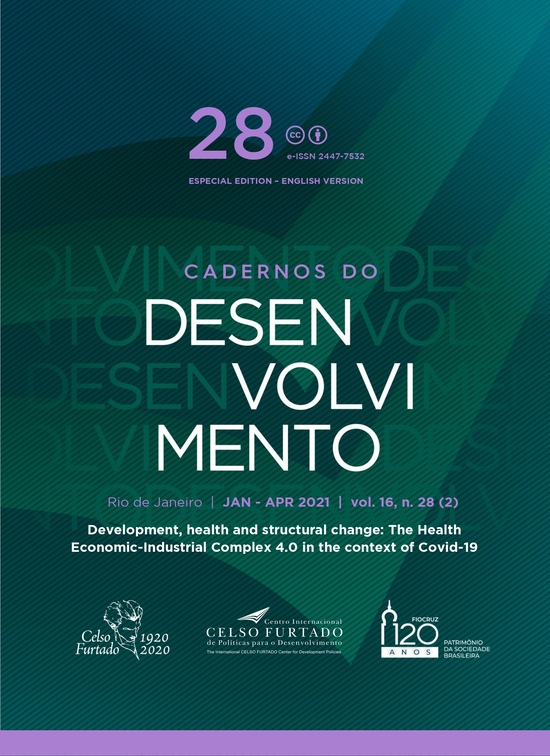The Covid-19 sanitary crisis and the productivity and technological vulnerability of the Health Economic-Industrial Complex in Brazil within the context of financialization
Palavras-chave:
Covid-19, Health Economic-Industrial Complex (HEIC), Unified Health System (SUS), Industry 4.0, Production and Innovation SystemResumo
The paper analyses strategy changes in global leader firms of HEIC in order to evaluate the new accumulation dynamics and point out, in a preliminary way, the implications for the overcoming of the economic and social challenges in the health sector in Brazil. The hypothesis is that both the demand and the vulnerability of SUS, though having been accentuated in the sanitary crisis, had already been present due to the structural changes im- posed on HEIC with the event of this significant set of shifts in the strategies of capitalist accumulation. Understanding these changes on a global scale is crucial to evaluate the structural productive and technological vulnerability of HEIC in Brazil and to design feasible, effective public policies to consolidate SUS in connection with productive and technological advances, thus promoting long- term socioeconomic development.Downloads
Referências
BUSFIELD, J. Documenting the financialisation of the pharmaceutical industry. Social Science & Medicine, v. 258, n. 113093, p. 2-8, 2020.
CLEARY, E. G. et al. Contribution of NIH funding to new drug approvals 2010-2016. PNAS (Proceedings of National Academy of Sciences), v. 115, n. 10, p. 2329-2334, 2018.
GADELHA C. A. G. Política industrial, desenvolvimento e os grandes desafios nacionais. In: LASTRES, H. M. M. et al. (Orgs.). O futuro desenvolvimento. Campinas, SP: Ed. Unicamp, 2006.
GADELHA, C. A. G.; TEMPORÃO, J. G. Desenvolvimento, inovação e saúde: a perspectiva teórica e política do Complexo Econômico-Industrial da Saúde. Ciência & Saúde Coletiva, v. 23, n. 6, p. 1891-1902, 2018.
GOTHAM, D. et al. Pills and Profits. How drug companies make a killing out of public research. Global Justice Now/Stop Aids, 2017. Available: https://www.globaljustice.org.uk/sites/default/files/files/resources/pills-and-profits-report-web.pdf. Access: July 1st, 2020.
I-MAK. Overpatented, Overpriced: how excessive pharmaceutical patenting is extending monopolies and driving up drug prices. I-MAK report, 2018. Available: http://www.i-mak.org/wp-content/uploads/2018/08/I-MAK-Overpatented-Overpriced-Report.pdf. Access: July 15th, 2020.
MAZZUCATO, M. Mission-oriented innovation policies: challenges and opportunities. Industrial and Corporate Change, v. 27, n. 5, p. 803-815, 2018.
MAZZUCATO, M.; ROY, V. Rethinking Value in Health Innovation: from mystifications towards prescriptions. Journal of Economic Policy Reform, v. 22, n. 2, p. 101-119, 2019.
PRESCRIRE INTERNATIONAL. Drugs in 2019: a brief review. Prescrire International Outlook, v. 29, n. 214, p. 110-111, 2020. Available: https://english.prescrire.org/en/SummaryDetail.aspx?Issueid=214. Access: July 17th, 2020.
TULUM, Ö.; LAZONICK, W. Financialized Corporations in a National Innovation System: The U.S. pharmaceutical industry. International Journal of Political Economy, v. 47, p. 3-4; 281-316, 2018.
WIESLER, B.; MACGAURAN, N.; KAISER, T. New drugs: where did we go wrong and what can we do better? BMJ, v. 366, n. 4340, p. 1-8, 2019.
Downloads
Publicado
Como Citar
Edição
Seção
Licença
Autores que publicam nesta revista concordam com os seguintes termos:- Autores mantém os direitos autorais e concedem à revista o direito de primeira publicação, com o trabalho simultaneamente licenciado sob a Licença Creative Commons Attribution que permite o compartilhamento do trabalho com reconhecimento da autoria e publicação inicial nesta revista;
- Autores têm autorização para assumir contratos adicionais separadamente, para distribuição não-exclusiva da versão do trabalho publicada nesta revista (ex.: publicar em repositório institucional ou como capítulo de livro), com reconhecimento de autoria e publicação inicial nesta revista;
- Autores têm permissão e são estimulados a publicar e distribuir seu trabalho online (ex.: em repositórios institucionais ou na sua página pessoal) a qualquer ponto antes ou durante o processo editorial, já que isso pode gerar alterações produtivas, bem como aumentar o impacto e a citação do trabalho publicado (Veja O Efeito do Acesso Livre).


